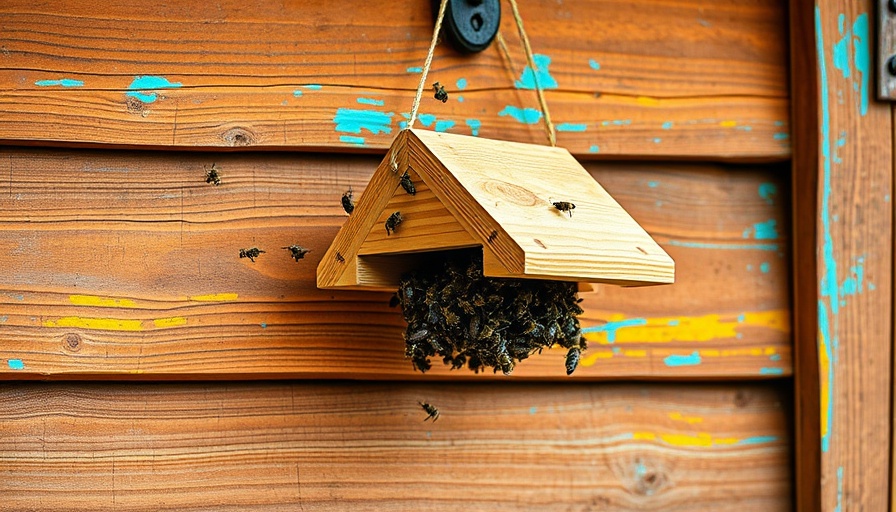
Understanding the Pest: The Carpenter Bee Crisis
Carpenter bees may seem innocuous, buzzing around your garden and home, but beneath their charming exterior lies a hidden threat that could lead to costly repairs. Unlike bumblebees, these solitary insects prefer to bore into wood to create their nests. This behavior can lead to significant damage, especially in untreated wooden structures. Homeowners often underestimate the potential costs associated with carpenter bee damage, which can escalate into thousands if not addressed promptly.
Significant Repair Costs from Carpenter Bees
Imagine finding holes in the siding of your home or noticing wood rot in your porch. Repairing such damage often entails not only replacing wood but also potentially addressing structural issues, which might include hiring contractors for extensive repairs. Estimates indicate that the cost to fix carpenter bee damage could range from hundreds to thousands of dollars depending on the extent of the infestation and damage. Therefore, investing in preventative measures such as carpenter bee traps can be a wise financial decision, costing only around $25 and saving you from more hefty bills down the road.
How Carpenter Bee Traps Work
Carpenter bee traps are designed to lure these pests into a container where they become trapped and cannot escape. The traps mimic the flowers these bees typically visit, utilizing specific scents and colors to attract them. This method is not only effective but also environmentally friendly as it allows for the safe capture and release or disposal of the bees without harming them unnecessarily. By utilizing these traps, homeowners can proactively safeguard their property against future infestations.
Tools and Techniques for Successful Trap Usage
To maximize the effectiveness of carpenter bee traps, it’s important to position them correctly around your property. Research suggests placing these traps conspicuously in areas where carpenter bees are frequently spotted, such as around wooden structures, decks, and eaves. Additionally, utilizing multiple traps can increase the chances of capturing more bees. Furthermore, regular maintenance and inspection of your traps can ensure that they continue to work effectively over time.
The Emotional Tree: Understanding Homeowner Anxiety
Homeowners often experience anxiety when it comes to pests invading their sanctuary. The thought of expensive repairs and damage can overshadow the joy of homeownership. Being proactive about pest control, especially with simple solutions like carpenter bee traps, not only offers peace of mind but also cultivates a sense of empowerment in maintaining one's property. By taking a hands-on approach, homeowners can reclaim their space and mitigate stress associated with potential property damage.
Future Trends in Eco-Friendly Pest Control
The future of pest control is trending towards more eco-friendly solutions, with products designed to attract and trap pests without harmful chemicals. As consumers become more environmentally conscious, innovations in pest management are adapting accordingly. By investing in traps and other preventive measures, homeowners not only protect their homes but also contribute to a healthier ecosystem. This shift aligns with broader trends in sustainable living and responsible homeownership, which could shape market offerings in the coming years.
Common Misconceptions About Carpenter Bees
One common misconception is that carpenter bees are simply harmless pollinators with little impact on homes. While they do contribute positively to the environment by pollinating flowers, their nesting habits can lead to costly repairs. Understanding the dual nature of these insects is crucial in deciding the best approach for managing their presence.
Be Proactive: Preventative Measures You Can Take
In addition to using carpenter bee traps, homeowners can take several proactive measures to deter these pests. Implementing regular inspections of wooden structures, applying paint or sealants to untreated wood, and using physical barriers can help create an inhospitable environment for carpenter bees. Engaging with local pest control services for personalized advice may also prove beneficial.
In conclusion, taking preventative measures against carpenter bees with simple traps can save homeowners significant repair costs. Understanding these pests and how to manage them empowers homeowners to maintain their properties effectively. By investing in cheap traps, home maintenance becomes a proactive effort rather than a costly reaction.
For those looking to protect their homes against carpenter bees, investing in traps is a small step with the potential for big savings. Don't let these pests ruin your peace of mind; take action today!
 Add Row
Add Row  Add
Add 




Write A Comment